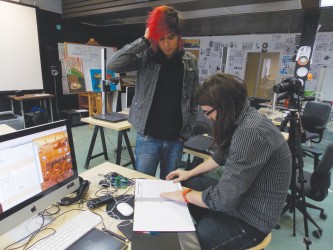Article Origin
Volume
Issue
Year
A comic book being published in Calgary will give young readers a chance to learn the Blackfoot language.
The graphic novel, entitled “Ihtsipatatiyoop” (“Creator” in English), will be a series of illustrations and text boxes designed to appeal to youth.
“The whole point is trying to develop a format that will get youth interested in learning an Aboriginal language,” said John Medeiros of Urban Society for Aboriginal Youth. “It’s all about just trying to package something up to get them engaged in the process.”
Medeiros is overseeing the project, which is funded by Canadian Heritage. Each of the 500 copies of the novel will include a DVD edition, as well as a documentary of the creative process behind it.
“We send them to reserves, schools... We have a lot here at the office for anyone that wants one, and we try to give them to as many youth organizations as possible,” said Medeiro. “They go pretty quick.”
The story centres around a young artist girl named Sage Sweetgrass, who becomes angry with her work and destroys it only to find out she has destroyed the whole world.
“It’s still a warrior story, but it’s like ragamuffin girl in her painting smock, and her journey to empowerment,” said Brian Batista, artistic director for the project. “The Creator comes down and says ‘Well, you just destroyed the world.’ So we have two creators in the story... Creator, the spiritual Creator, and also the human as a creator.”
The artistic team working on the project went with a more innovative approach to the formatting of the graphic novel—one that showcases the art more noticeably, as well as one that challenges traditional Western worldviews of what a comic (or a piece of literary and graphic art) should look like.
“We did away with the conventional blocks and panels, and everything is melded so it reads left to right,” said Mitchell Poundmaker, one of the eight young artists that worked on the story. “I like that we literally thought outside the box. So it’s these big, beautiful art pages with no fixed borders or boundaries.”
Elder Randy Bottle wrote a blessing for the book. He and his wife Anita Eaglebear, both from the Blood reserve, also translated 200-story panels from English text into Blackfoot. The couple spent three-and-a-half days doing the translations, and faced a variety of stumbling blocks.
“With the English phraseology, sometimes it was very difficult to follow because we don’t have Blackfoot words for those phrases,” said Bottle. “Sometimes it didn’t make sense to translate it the way it was written, so I had to turn things around and really think.”
For example, Sage uses the popular English phrase, “That’s cool.”
“When you say ‘that’s cool,’ it would mean it’s really good and something really extraordinary,” said Bottle. “But in Blackfoot, it would be ‘That’s cold.’ It would be completely different.”
In this case, Bottle and Eaglebear settled on the word “Iksookatii,” which means, “That’s good.” The translation isn’t direct, said Bottle, but it was the most accurate one they could come up with.
Regardless of the challenges, Bottle is happy to be part of such a unique effort to bring back the language and popularize it among youth.
“I think it’s something the young people are losing, because it’s not spoken often enough,” he said. “This was an opportunity to share the language of this land.”
Photo caption: Christian Boulet (standing), one of the artists for “Ihtsipatatiyoop,” discusses the project with artistic director Brian Batista.
- 2809 views

